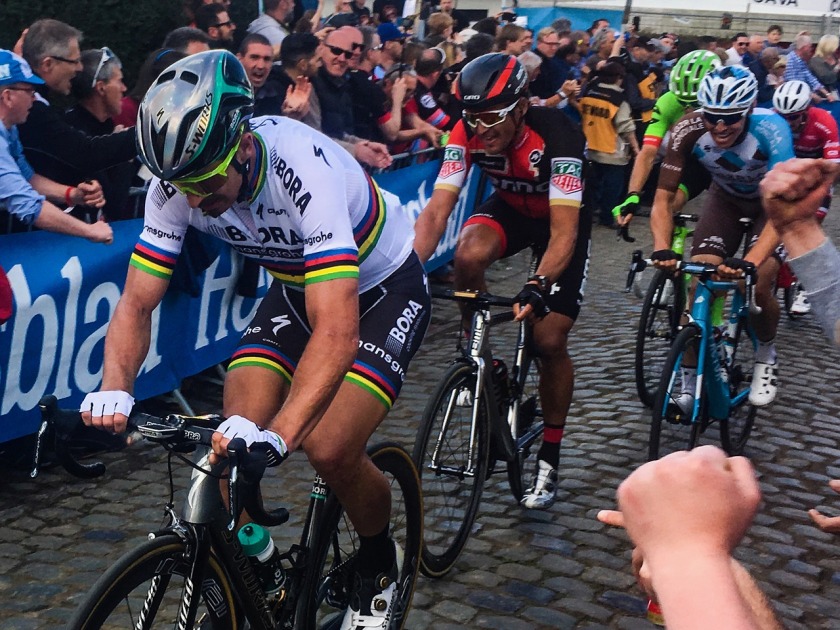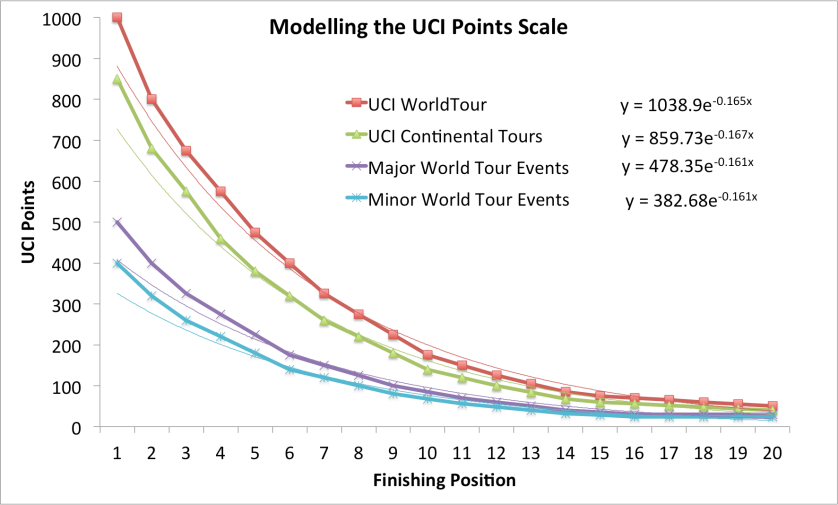
Following Il Lombardia last weekend, the World Tour has only two more events this year. It is time to ask who were the best sprinters of 2017? Who was the best climber or puncheur? The simplest approach is to count up the number of wins, but this ignores the achievement of finishing consistently among the top riders on different types of parcours. This article explores ways of creating rankings for different types of riders.
The current UCI points system, introduced in 2016, is fiendishly complicated, with points awarded for winning races and bonuses given to those wearing certain jerseys in stage races. The approach applies different scales according to the type of event, but each of these scales puts a premium on winning the race, with points awarded for first place being just over double the reward of the fifth-placed rider. In fact, taking the top 20 places in the four main world tour categories of event, the curve of best fit is exponential with a coefficient of approximately -1/6. In other words, there’s a linear relationship between a rider’s finishing position and the logarithm of the UCI points awarded.

This observation is really useful, because it provides a straightforward way of assessing the performance in different types of races, based on their finishing positions. The PCS web site is great source of professional cycling statistics. One nice feature is that most of the races/stages have an associated profile indicated by a little logo, see Tour de France. These classify races into the following categories:
- Flat e.g. TdF stage 2 from Düsseldorf to Liège
- Hills with a flat finish e.g. Milan San Remo
- Hills with an uphill finish e.g. Fleche Wallonne
- Mountains with a flat finish e.g. TdF stage 8 Station des Rousses
- Mountains with an uphill finish e.g. TdF stage 5 La Planche des Belles Filles
- It is also reasonable to assume that any stage of less than 80km was a TT
We would expect outright sprinters to top the rankings in flat races, whereas the puncheurs come to the fore when it becomes hilly, with certain riders doing particularly well on steep uphill finishes. The climbers come into their own in the mountains, with some being especially strong on summit finishes.
Taking the results of all the World Tour races in 2017 completed up to Il Lobardia and applying the simple -1/6 exponential formula equally to all categories of event, we obtain the following “derived ranking”, arranged by the profile of event.
Derived ranking for 2017 World Tour events, according to parcours

Marcel Kittel rightly tops the sprinters on flat courses (while Cavendish was 11th), but the Katusha Alpecin rider and several others have tended to be dropped on hilly courses, where Sagan, Ewan and Kristoff were joined by Trentin, Gaviria and some classic puncheurs. Sagan managed to win some notable uphill finishes, such as Tirreno-Adriatico and Grand Prix Cycliste de Quebec, alongside riders noted for being strong in the hills. The aggression of Valverde and Contador put them ahead of Froome on mountain stages that finished on the flat, but the TdF winner, Zakarin and Bardet topped the rankings of pure climbers for consistency on summit finishes. Finally we see the usual suspects topping the TT rankings.
It should be noted that ranking performances based simply on positions, without some form of scaling, gave very unintuitive results. While simpler than the UCI points system, this analysis supports the idea of awarding points in a way that scales exponentially with the finishing position of a rider.
